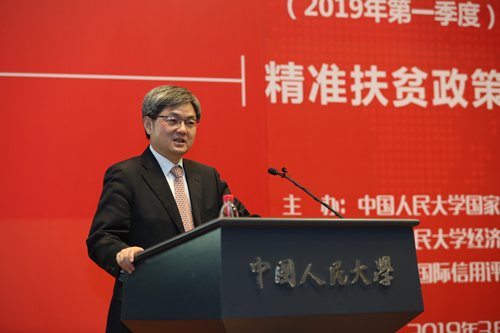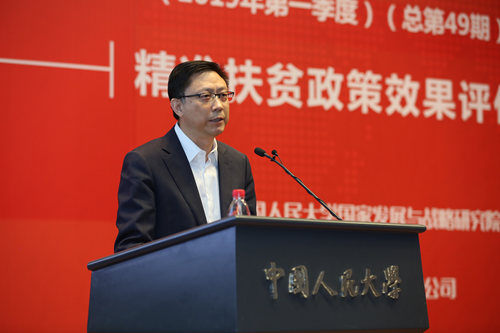 Research Update
Research Update
18
MarOn March 16, 2019, China's Macroeconomic Forum (Q1 2019) with the theme of “Assessment of Precise Poverty Alleviation Policy” jointly hosted by National Academy of Development and Strategy (NADS), School of Economics at Renmin University of China (RUC), and China Chengxin International Credit Rating Co., Ltd. (CCXI), was successfully held at RUC.

Attendees of the Forum are Zhang Qi, Dean of China Institute for Poverty Reduction, Beijing Normal University, Yang Ruilong, Joint Dean of Institute of Economic Research, RUC, Liu Shouying, Dean at School of Economics, RUC, Wang Sangui, Dean of China Institute for Poverty Reduction, RUC, Liu Fengliang, Executive Deputy Dean of Graduate School, RUC, Yan Yan, Chairman of CCXI, Joint Deputy Dean of Institute of Economic Research, RUC, Zheng Xinye, Dean of School of Applied Economics, RUC, Huang Juan, Deputy Dean of School of Applied Economics, RUC, Huang Shisong, Research Fellow of NADS, RUC.

Yang Ruilong, Joint Dean of Institute of Economic Research, RUC, moderated the first session of the Forum.

Zheng Xinye, Dean of School of Applied Economics, RUC, presented the report on a case study of precise poverty alleviation policy on behalf of the research group.
Based on the study of Xinxian County at Xinyang City, Henan Province, the report mainly answered five questions about Chinese precise poverty relief policy: its accuracy, the short-term effect, the long-term influence, fiscal support and future budget it needs, and the characteristics of the poverty-returning population.
First, the precise poverty relief policy stressed more on how to precisely identify the people who is really in need of government support; how to precisely identify the actual demands of the poor individuals; and how to precisely identify their demands for public facilities. In 2017, up to 12.8% population that didn’t meet the poverty standard was excluded from the government support as they owned big houses at the County or in other cities. As poverty of each family might be caused by different reasons such as family members are being disabled, sick, old, local government offered a wide range of policy options to meet their various needs. In addition, a secretary was dispatched to every village so that the local government can better understand the public’s real needs and offer them appropriate public facilities.
Second, the precise poverty relief policies increased the utilization ratio of factors like agricultural and forestry land, labor force by means of building infrastructures, factories, clinics, and providing jobs, education and insurance service. In 2017, the local farmers saw their productive income increased by 0.7 times, active labor force’s average working time grew from 2.8 months in 2014 to 4.6 months in 2017. For a long-term development, the government significantly improved the standards of local education, healthcare, housing, and transportation.
Third, from 2014 to 2017, the government poured a large number of funds into precise poverty as fiscal support for registered poor population reached 35.9 thousand yuan per person. 63% of the total financial inputs were spent on infrastructure building, and major projects requiring massive funds such as resident resettlement and relocation, dilapidated housing transformation, land readjustment, safe water inspection, and cultural square building have been generally completed. Therefore, the fiscal pressure in the future is expected to reduce.
Fourth, 70% of the total families in poverty are burden with serious diseases or disability, and even if the government helped them shaking off the poverty temporarily, the possibility of them returning to previous status is still high. Because they in general are poorly educated and unable to work, once the government cut the spending on poverty relief, those families will be left without major source of income.
In the end, the report proposed several recommendations on promoting a long-term and sustainable development of Chinese poverty alleviation.
First, China shall optimize the system of precise poverty alleviation and take into consideration the different needs of different villages and families, by encouraging decision-makers to have more people in poverty participated into policy design, and making sure the government support is matched with people’s actual demands.
Second, natural resources like the farmland and forestry must be protected from pollution, which is conducive to stabilize the agricultural output and market price. Meanwhile, the government shall support industrial development at the village or town level so that the agricultural capital can be transferred into non-agricultural capital, from which the farmers can earn rent and share profits.
Third, the government shall offer incentive initiatives to increase labor supply of the poor population. The big cities in need of labor force could cooperate with the villages, providing people who are able to work a position. At the same time, the government shall encourage and guide the market to invest more at village or town, making full use of the abundant manpower and their free time.
Fourth, the poorest population without any ability to work including the disabled, elderly, children, and patient shall be transferred from the poverty-relief system to the social assistance system.
Fifth, more attention shall be paid to the mid/long-term assessment of the poverty relief policies since the many effects in terms of human capital, infrastructure facilities building are still to be seen years after.

Yan Yan, Chairman of CCXI, Joint Deputy Dean of Institute of Economic Research, RUC, hosted the panel discussions of Chinese macroeconomic situations.